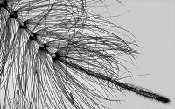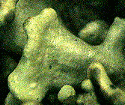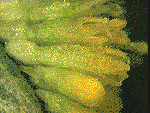![]() April
April
Please read the important notes on collecting.
The days are getting longer and the spring flowers are
beginning to show. The naturalist will soon be spoilt for choice
of subjects to study in close-up with both the hand lens in the
field and for the microscope back home.
The recurring theme in these seasonal nature studies is that even
the commonest things in nature offer a whole new world to study
when examined in close-up. So this month we examine the humble
daisy, the mosquito you love to hate and lichens.
 The mosquito (family Culicidae) hardly needs
introducing, the itchy swelling resulting from the female taking
a tasty snack of your blood is familiar to everybody. However,
mosquitoes and other small flies are fascinating in close-up,
either with the hand lens or low power stereo microscope. A good
source of them for study is any spiders web left over from last
season eg in the shed or garage. Webs are also a rich source of
other insects to study. The webs in my garage for example are
full of green lacewings (family Chrysopidae).
The mosquito (family Culicidae) hardly needs
introducing, the itchy swelling resulting from the female taking
a tasty snack of your blood is familiar to everybody. However,
mosquitoes and other small flies are fascinating in close-up,
either with the hand lens or low power stereo microscope. A good
source of them for study is any spiders web left over from last
season eg in the shed or garage. Webs are also a rich source of
other insects to study. The webs in my garage for example are
full of green lacewings (family Chrysopidae).
 Until
the advent of microscopy, lichens were classified as a single
organism. But early studies revealed that lichens are a close
association for mutual benefit of algae and fungi ie symbiosis.
Lichens occur in a range of morphologies and colours, from the
attractive crusts growing on gravestones or rocky seashores to
the leafy forms found on trees.
Until
the advent of microscopy, lichens were classified as a single
organism. But early studies revealed that lichens are a close
association for mutual benefit of algae and fungi ie symbiosis.
Lichens occur in a range of morphologies and colours, from the
attractive crusts growing on gravestones or rocky seashores to
the leafy forms found on trees.
Lichens are very slow growing and should not be removed from a substrate (particularly rocks or gravestones) but examined in situ with a hand lens. If a dead twig or piece of bark has fallen off a tree and has lichen growing on it, small pieces can usually be taken for study at home without damaging a habitat. (But see Important Notes on Collecting).
The lichen shown right was found on a dead twig (species uncertain). Examine habitats such as tree bark, fallen branches, heaths, gravestones, rocky seashores - each habitat usually has distinctive species if you live in an unpolluted area. Lichens have assumed an important role in pollution monitoring because many species are intolerant to air pollution such as sulphur dioxide.
 Like me, you have
probably walked passed the humble daisy (Bellis perennis)
or it's relatives in the Compositae family many times without a
second glance. But it is well worth studying under the 10X lens
and low power stereo microscope. As the family name suggests it
is not a single flower but a composite of flowers. The best way
to appreciate this is to cut a flowerhead in half with a knife
along the axis of the stem. The image on the left above shows a
split flowerhead.
Like me, you have
probably walked passed the humble daisy (Bellis perennis)
or it's relatives in the Compositae family many times without a
second glance. But it is well worth studying under the 10X lens
and low power stereo microscope. As the family name suggests it
is not a single flower but a composite of flowers. The best way
to appreciate this is to cut a flowerhead in half with a knife
along the axis of the stem. The image on the left above shows a
split flowerhead.
Why not join me next month to study nature in close-up in Spring?
Your local library should have introductory texts on botany that should explain the structure of flowers of the Compositae family and the symbiotic relationship of algae and fungi in lichens. The larger encyclopaedias such as Encyclopaedia Britannica are also worth consulting.
The line drawing at the head of this page was taken from L C Miall's Aquatic Insects, Macmillan, London 1912. This is a delightful book with excellent line drawings...worth looking out for in the secondhand bookshops.
Images were taken using a CCD camera attached to the eyepiece
tube of a stereo microscope using a x1 paired objective with no
eyepiece. Camera images were transferred to the PC using a
Creative Video Spigot capture card.
Image manipulation using Photostyler v2.0 software.
Return to Walk Index
Comments to Dave Walker